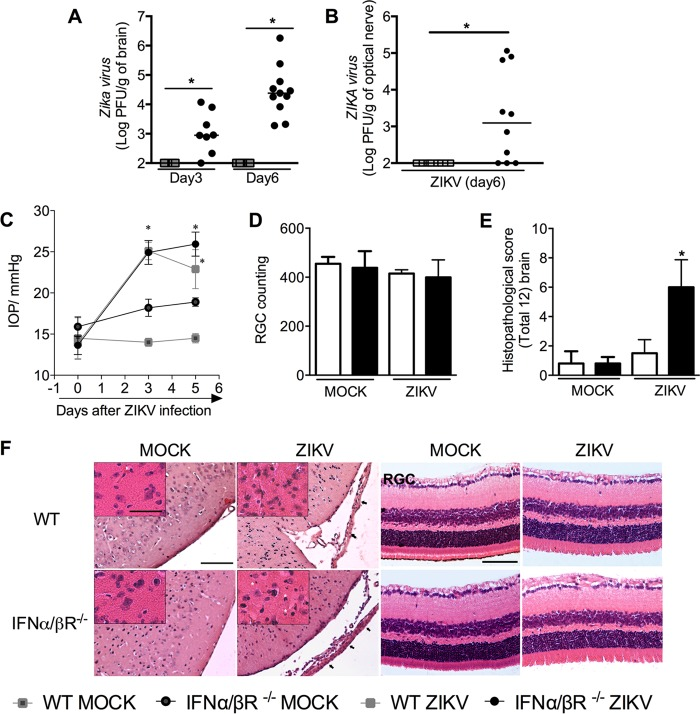N-Methyl-d-Aspartate (NMDA) Receptor Blockade Prevents Neuronal Death Induced by Zika Virus Infection
Zika virus (ZIKV) infection is a global health emergency that causes significant neurodegeneration. Neurodegenerative processes may be exacerbated by N -methyl-d-aspartate receptor (NMDAR)-dependent neuronal excitoxicity. Here, we have exploited the hypothesis that ZIKV-induced neurodegeneration can be rescued by blocking NMDA overstimulation with memantine. Our results show that ZIKV actively replicates in primary neurons and that virus replication is directly associated with massive neuronal cell death. Interestingly, treatment with memantine or other NMDAR blockers, including dizocilpine (MK-801), agmatine sulfate, or ifenprodil, prevents neuronal death without interfering with the ability of ZIKV to replicate in these cells. Moreover, in vivo experiments demonstrate that therapeutic memantine treatment prevents the increase of intraocular pressure (IOP) induced by infection and massively reduces neurodegeneration and microgliosis in the brain of infected mice. Our results indicate that the blockade of NMDARs by memantine provides potent neuroprotective effects against ZIKV-induced neuronal damage, suggesting it could be a viable treatment for patients at risk for ZIKV infection-induced neurodegeneration. IMPORTANCE Zika virus (ZIKV) infection is a global health emergency associated with serious neurological complications, including microcephaly and Guillain-Barré syndrome. Infection of experimental animals with ZIKV causes significant neuronal damage and microgliosis. Treatment with drugs that block NMDARs prevented neuronal damage both in vitro and in vivo These results suggest that overactivation of NMDARs contributes significantly to the neuronal damage induced by ZIKV infection, and this is amenable to inhibition by drug treatment.
Authors
Vivian V Costa; Juliana L Del Sarto; Rebeca F Rocha; Flavia R Silva; Juliana G Doria; Isabella G Olmo; Rafael E Marques; Celso M Queiroz-Junior; Giselle Foureaux; Julia Maria S Araújo; Allysson Cramer; Ana Luíza C V Real; Lucas S Ribeiro; Silvia I Sardi; Anderson J Ferreira; Fabiana S Machado; Antônio C de Oliveira; Antônio L Teixeira; Helder I Nakaya; Danielle G Souza; Fabiola M Ribeiro; Mauro M Teixeira
External link
Publication Year
Publication Journal
Associeted Project
Microbiology or Immunology
Lista de serviços
-
Genomic analyses reveal broad impact of miR-137 on genes associated with malignant transformation and neuronal differentiation in glioblastoma cells.Genomic analyses reveal broad impact of miR-137 on genes associated with malignant transformation and neuronal differentiation in glioblastoma cells.
-
RNA-Binding Protein Musashi1 Is a Central Regulator of Adhesion Pathways in Glioblastoma.RNA-Binding Protein Musashi1 Is a Central Regulator of Adhesion Pathways in Glioblastoma.
-
MicroRNA Transcriptome Profiling in Heart of Trypanosoma cruzi-Infected Mice: Parasitological and Cardiological Outcomes.MicroRNA Transcriptome Profiling in Heart of Trypanosoma cruzi-Infected Mice: Parasitological and Cardiological Outcomes.
-
Genome mapping and expression analyses of human intronic noncoding RNAs reveal tissue-specific patterns and enrichment in genes related to regulation of transcription.Genome mapping and expression analyses of human intronic noncoding RNAs reveal tissue-specific patterns and enrichment in genes related to regulation of transcription.
-
Antimicrobial peptide LL-37 participates in the transcriptional regulation of melanoma cells.Antimicrobial peptide LL-37 participates in the transcriptional regulation of melanoma cells.
-
Down-regulation of 14q32-encoded miRNAs and tumor suppressor role for miR-654-3p in papillary thyroid cancer.Down-regulation of 14q32-encoded miRNAs and tumor suppressor role for miR-654-3p in papillary thyroid cancer.
-
Integration of miRNA and gene expression profiles suggest a role for miRNAs in the pathobiological processes of acute Trypanosoma cruzi infection.Integration of miRNA and gene expression profiles suggest a role for miRNAs in the pathobiological processes of acute Trypanosoma cruzi infection.
-
Integrative Biology Approaches Applied to Human DiseasesIntegrative Biology Approaches Applied to Human Diseases
-
Proteomics reveals disturbances in the immune response and energy metabolism of monocytes from patients with septic shock.Proteomics reveals disturbances in the immune response and energy metabolism of monocytes from patients with septic shock.
-
Genomics, epigenomics and pharmacogenomics of Familial Hypercholesterolemia (FHBGEP): A study protocol.Genomics, epigenomics and pharmacogenomics of Familial Hypercholesterolemia (FHBGEP): A study protocol.
-
Melatonin-Index as a biomarker for predicting the distribution of presymptomatic and asymptomatic SARS-CoV-2 carriersMelatonin-Index as a biomarker for predicting the distribution of presymptomatic and asymptomatic SARS-CoV-2 carriers
-
Profiling plasma-extracellular vesicle proteins and microRNAs in diabetes onset in middle-aged male participants in the ELSA-Brasil study.Profiling plasma-extracellular vesicle proteins and microRNAs in diabetes onset in middle-aged male participants in the ELSA-Brasil study.
-
Big Data and machine learning in cancer theranosticsBig Data and machine learning in cancer theranostics
-
Genomic positional conservation identifies topological anchor point RNAs linked to developmental loci.Genomic positional conservation identifies topological anchor point RNAs linked to developmental loci.
-
Integrative systems immunology uncovers molecular networks of the cell cycle that stratify COVID-19 severityIntegrative systems immunology uncovers molecular networks of the cell cycle that stratify COVID-19 severity

